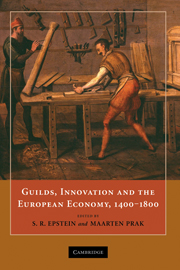Book contents
- Frontmatter
- Contents
- List of Contributors
- Acknowledgments
- Introduction: Guilds, Innovation, and the European Economy, 1400–1800
- 1 Craft Guilds, the Theory of the Firm, and Early Modern Proto-industry
- 2 Craft Guilds, Apprenticeship, and Technological Change in Pre-industrial Europe
- 3 Subcontracting in Guild-based Export Trades, Thirteenth–Eighteenth Centuries
- 4 Circulation of Skilled Labour in Late Medieval and Early Modern Central Europe
- 5 Painters, Guilds, and the Art Market during the Dutch Golden Age
- 6 Craft Guilds and Technological Change: The Engine Loom in the European Silk Ribbon Industry in the Seventeenth and Eighteenth Centuries
- 7 Guilds, Technology, and Economic Change in Early Modern Venice
- 8 Inventing in a World of Guilds: Silk Fabrics in Eighteenth-century Lyon
- 9 ‘Not to Hurt of Trade’: Guilds and Innovation in Horology and Precision Instrument Making
- 10 Reaching beyond the City Wall: London Guilds and National Regulation, 1500–1700
- 11 Guilds in Decline? London Livery Companies and the Rise of a Liberal Economy, 1600–1800
- Index
Introduction: Guilds, Innovation, and the European Economy, 1400–1800
Published online by Cambridge University Press: 24 June 2009
- Frontmatter
- Contents
- List of Contributors
- Acknowledgments
- Introduction: Guilds, Innovation, and the European Economy, 1400–1800
- 1 Craft Guilds, the Theory of the Firm, and Early Modern Proto-industry
- 2 Craft Guilds, Apprenticeship, and Technological Change in Pre-industrial Europe
- 3 Subcontracting in Guild-based Export Trades, Thirteenth–Eighteenth Centuries
- 4 Circulation of Skilled Labour in Late Medieval and Early Modern Central Europe
- 5 Painters, Guilds, and the Art Market during the Dutch Golden Age
- 6 Craft Guilds and Technological Change: The Engine Loom in the European Silk Ribbon Industry in the Seventeenth and Eighteenth Centuries
- 7 Guilds, Technology, and Economic Change in Early Modern Venice
- 8 Inventing in a World of Guilds: Silk Fabrics in Eighteenth-century Lyon
- 9 ‘Not to Hurt of Trade’: Guilds and Innovation in Horology and Precision Instrument Making
- 10 Reaching beyond the City Wall: London Guilds and National Regulation, 1500–1700
- 11 Guilds in Decline? London Livery Companies and the Rise of a Liberal Economy, 1600–1800
- Index
Summary
Craft guilds, Adam Smith famously suggested in 1776, are ‘a conspiracy against the public’, and the government should ‘do nothing to facilitate such assemblies, much less to render them necessary’. As in so much other economic thinking, Smith was a trendsetter in this too. Not only were his ideas about guilds shared by some of his late eighteenth-century contemporaries, they seemed to apply almost overnight when French revolutionaries abolished the guilds, first in France (in 1791) and then in much of the rest of continental Europe. For a long time, historians have interpreted the simultaneity of ideas and policies as definitive proof that the guilds had outlived themselves as the gothic remnants of a bygone age and should make way for the modern world of the steam engine and laissez-faire. Guilds, in other words, were seen as part of an economic system that had prevented the European economy from realising its full economic potential. It was, if anything, a demonstration of the validity of this argument, that England was the first European country to lose its guilds – English guilds were supposed to have vanished through some unplanned process starting in the second half of the seventeenth century – and also the first country to industrialise.
The negative view of guilds survived for the best part of two centuries in history textbooks and specialised works.
- Type
- Chapter
- Information
- Publisher: Cambridge University PressPrint publication year: 2008
- 12
- Cited by



